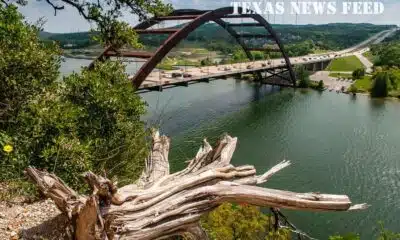News from the South - North Carolina News Feed
Why is so much plastic hung up in trees and shrubs, and when will it get cleaned up? Will Asheville Muni close at the end of March? • Asheville Watchdog
Today’s round of questions, my smart-aleck replies and the real answers:
Question: Why is there so much plastic hung up in trees and shrubs from Helene? Where did it all come from? Will anyone clean it up? When?
My answer: This is undoubtedly the worst Christo exhibit ever. I just don’t get his vision on this one.
Real answer: It is hard to miss all of the debris still hanging from trees and brush along our river and stream banks. Naturally, Tropical Storm Helene is to blame.
The 1,000-year rains swelled rivers to upward of 30 feet deep in some places. That’s high enough to get into the tree line, and that’s where a lot of debris landed.
The debris remains highly noticeable, said Anna Alsobrook, the French Broad watershed science and policy manager at MountainTrue, an Asheville environmental nonprofit.
“While it’s gotten better with the help of volunteers picking it up in places, the amount of plastic hanging from trees looks apocalyptic,” Alsobrook told me via email. “Take a minute and think about how hard it is for us as individual consumers to buy anything that’s not wrapped in or packaged in plastic. The same is true for retailers, manufacturers, and industries, but the amount and volume is much greater for them.”
Whatever was next to our rivers and streams went into the water, including plastic.
“So, when a building was flooded, anything inside of it came out, including all the packaging, plastic waste, etc., that may have been inside,” Alsobrook said. “On top of that, plastic is a major part of building material — whether as insulation or under roofing.”
We do have some good news to report.
“MountainTrue is working to clean up where and how we can with the help of some really rockstar volunteers,” Alsobrook said. “I’m telling you, they have braved some subpar conditions lately! That being said, we are staying out of the way of the debris contractors hired to remove the bigger debris, like cars, tankers etc.”
Hartwell Carson, the French Broad riverkeeper with MountainTrue, provided details on river cleanup progress.
“Between our Green Riverkeeper, French Broad Riverkeeper and Watauga Riverkeeper programs, we have hauled out over 2.8 million pounds of garbage from our rivers since the storm,” Carson said. “We have hired a full-time cleanup coordinator, acquired a new vehicle and purchased a dump trailer. We are also employing over a dozen raft guides in Madison County to clean up the whitewater section of the French Broad River and are hoping to ramp up our cleanup team to include 25 to 50 staff.”

Additionally, the U.S. Army Corps of Engineers announced Feb. 1 that the Corps, “in coordination with federal, state, and local partners, has officially launched a waterway debris removal mission in North Carolina to support recovery efforts following Hurricane Helene.
“The mission focuses on clearing storm-related debris from navigable waterways, ensuring public safety, protecting critical infrastructure, and preserving the environment,” the Corps said in the news release.
Col. Brad Morgan, Wilmington District Commander for the Corps, noted that Helene “left significant debris in key waterways, posing risks to recreation and ecosystems.
The Corps said the recovery work will be done “in close coordination with local agencies and stakeholders.”
Carson said they’ve learned that the Army Corps’s cleanup efforts, “for now, will only cover major tributaries and only big debris that threatens critical infrastructure.
“Think cars, shipping containers, etc.,” Carson said. “That means there will be a huge amount of trash left after the cleanup effort and MountainTrue is stepping up to make sure this trash is cleaned up, so we can get back on our rivers and outfitters reopen.”
Plastic material stuck in trees is “a good example of the kind of trash that the Army Corps won’t be removing,” Carson said.
Stacey Reese, a spokesperson for the Corps, said via email they are tasked with removing these types of debris: vegetative, construction and demolition, titled property (boats, cars, etc.), white goods, and hazardous materials.”
“We will work on points given to us by the county and FEMA, and (we’ll be) working in areas FEMA deems eligible,” Reese said. “The waterway debris removal began in Buncombe County, Azalea Park area on Saturday.”
Alsobrook said once the Corps’ teams have completed the heavy machinery work, “we plan to come back in and tackle the hand-pickable items.”
If you’re interested in volunteering, check MountainTrue’s events calendar at mountaintrue.org/events.

Question: I just heard that the Asheville Muni Golf Course may close in March. If true, that is not fair to those who paid for a season’s pass. The first three months of the year there is limited play due to winter weather. Can you get details?
My answer: I recently played the back nine of the Muni twice consecutively, as only the back nine is open now. I was thinking that playing the same nine twice, I naturally would smoke the course and shoot my best score ever. Funny how that didn’t work out.
Real answer: Closure is highly unlikely.
The Muni’s front nine, the part closest to Swannanoa River Road and the river itself, was heavily damaged, but the back nine reopened in October, after the city cleared multiple downed trees.
“The front nine will clearly be some time before we are able to reopen,” said Chris Corl, the city of Asheville’s director of community and regional entertainment facilities.

Corl noted that City Council in December approved an amendment to the licensing and management agreement contract with Commonwealth Golf Partners to operate the course that adjusted the profit-and-loss share structure between the city and Commonwealth. It placed 100 percent of profits and loss with the city, paying Commonwealth a small monthly management fee to operate the course on the city’s behalf, Corl said.
“Included was a provision that beginning April 1, 2025, the agreement would revert back to the original profit-and-loss share structure, which is roughly a 50/50 split between the city and Commonwealth,” Corl said.
The amendment covering Oct. 1, 2024 through March 31, 2025 is designed to give the city time to work out a longer-term, temporary agreement with Commonwealth. Corl said the city is in conversation with Commonwealth to determine “what a contract structure can look like, assuming that the course remains a nine-hole course for up to two years, as we work through the process to rebuild while following the necessary steps and timelines associated with potential FEMA reimbursement.”
Regarding the 2025 annual passes, the city purposely formulated them with quarterly payments to allow for the potential shakeup in the operating structure starting April 1.
“I understand that this January we’ve had an abnormally high number of days with the course closed due to weather, but that is always a possibility in the winter and affects annual passholders and non-passholders every year,” Corl said.
The bottom line, Corl said, “is that the course will not close in March.
“However, I should be clear that we have an existing approved agreement through March 31,” Corl said. “April 1 and after, we are still working through, and all options are on the table, as reverting to the original contract structure pre-storm is not feasible for us and Commonwealth.”
“We’re certainly doing everything in our power to work on a result and a financial model that continues course operations, but to be prudent stewards of our current financial situation, we need to look at all potential options,” Corl continued.
Michael Bennett, a partner in Commonwealth Golf Partners, said Corl’s assessment is correct. He also noted that the annual passes are paid only through the end of March.
Closure is doubtful, Bennett said.
“I just don’t see it,” Bennett said. “Chris has been very good to work with.”
Bennett noted that the course was in great shape before Helene, with the restoration nearly complete.
“We really just finished everything except for those two bunkers on 18 — that was the only thing we had left to do,” Bennett said. “We stopped in June because we didn’t want to disturb them ahead of the Skyview Tournament.”
Business was good before the storm, Bennett said, and he noted that the course, a Donald Ross design dating to the 1920s, still has fantastic potential.
“So to close it would be pretty tragic,” Bennett said. “I don’t think anybody really thinks that that’s going to happen. It’s just more mechanical — like, ‘OK, how do we continue to fund this while it’s just a nine-hole golf course?’ Because it’s nearly impossible to make any money operating a nine-hole golf course, because the expenses aren’t half of what you might think they are.”
Corl said before Helene the city was about 95 percent done with the renovation project. As of September 2024, the city had spent $3,018,468 on it.
The city received funds towards the project from the Buncombe County Tourism Development Authority’s Tourism Product Development Fund, the Donald Ross Society Foundation, hole sponsorships, private donations made through the Friends of Asheville Municipal, and the city.
For now, Bennett said, the idea is to keep maintaining the course, and find a way to keep it open and at least not losing money.
Bennett said the “worst-case scenario” for the front nine to remain closed is probably about two years, although he emphasized nothing has been determined on the rebuilding schedule.
He did note that Commonwealth and the city submitted a detailed damage assessment to FEMA about two weeks ago, so he’s optimistic that will help to get the process rolling.
“Because we were one of the first ones in, we all believe that we’ll be one of the early ones to get reviewed,” Bennett said.
Asheville Watchdog is a nonprofit news team producing stories that matter to Asheville and Buncombe County. Got a question? Send it to John Boyle at jboyle@avlwatchdog.org or 828-337-0941. His Answer Man columns appear each Tuesday and Friday. The Watchdog’s reporting is made possible by donations from the community. To show your support for this vital public service go to avlwatchdog.org/support-our-publication/.
Related
The post Why is so much plastic hung up in trees and shrubs, and when will it get cleaned up? Will Asheville Muni close at the end of March? • Asheville Watchdog appeared first on avlwatchdog.org
News from the South - North Carolina News Feed
White House officials hold prayer vigil for Charlie Kirk
SUMMARY: Republican lawmakers, conservative leaders, and Trump administration officials held a prayer vigil and memorial at the Kennedy Center honoring slain activist Charlie Kirk, founder of Turning Point USA. Kirk was killed in Utah, where memorials continue at Utah Valley University and Turning Point USA’s headquarters. Police say 22-year-old Tyler Robinson turned himself in but has not confessed or cooperated. Robinson’s roommate, his boyfriend who is transitioning, is cooperating with authorities. Investigators are examining messages Robinson allegedly sent on Discord joking about the shooting. Robinson faces charges including aggravated murder, obstruction of justice, and felony firearm discharge.
White House officials and Republican lawmakers gathered at the Kennedy Center at 6 p.m. to hold a prayer vigil in remembrance of conservative activist Charlie Kirk.
https://abc11.com/us-world/
Download: https://abc11.com/apps/
Like us on Facebook: https://www.facebook.com/ABC11/
Instagram: https://www.instagram.com/abc11_wtvd/
Threads: https://www.threads.net/@abc11_wtvd
TIKTOK: https://www.tiktok.com/@abc11_eyewitnessnews
News from the South - North Carolina News Feed
Family, friends hold candlelight vigil in honor of Giovanni Pelletier
SUMMARY: Family and friends held a candlelight vigil in Apex to honor Giovanni Pelletier, a Fuquay Varina High School graduate whose body was found last month in a Florida retention pond. Giovanni went missing while visiting family, after reportedly acting erratically and leaving his cousins’ car. Loved ones remembered his infectious smile, laughter, and loyal friendship, expressing how deeply he impacted their lives. His mother shared the family’s ongoing grief and search for answers as authorities continue investigating his death. Despite the sadness, the community’s support has provided comfort. A celebration of life mass is planned in Apex to further commemorate Giovanni’s memory.
“It’s good to know how loved someone is in their community.”
More: https://abc11.com/post/giovanni-pelletier-family-friends-hold-candlelight-vigil-honor-wake-teen-found-dead-florida/17811995/
Download: https://abc11.com/apps/
Like us on Facebook: https://www.facebook.com/ABC11/
Instagram: https://www.instagram.com/abc11_wtvd/
Threads: https://www.threads.net/@abc11_wtvd
TIKTOK: https://www.tiktok.com/@abc11_eyewitnessnews
News from the South - North Carolina News Feed
NC Courage wins 2-1 against Angel City FC
SUMMARY: The North Carolina Courage defeated Angel City FC 2-1 in Cary, ending their unbeaten streak. Monaca scored early at the 6th minute, followed by Bull City native Brianna Pinto’s goal at the 18th minute, securing a 2-0 halftime lead. Angel City intensified in the second half, scoring in the 88th minute, but the Courage held firm defensively to claim victory. Pinto expressed pride in the win, emphasizing the team’s unity and playoff ambitions. Nearly 8,000 fans attended. Coverage continues tonight at 11, alongside college football updates, including the Tar Heels vs. Richmond game live from Chapel Hill.
Saturday’s win was crucial for the Courage as the regular season starts to wind down.
https://abc11.com/post/north-carolina-courage-wins-2-1-angel-city-fc/17810234/
Download: https://abc11.com/apps/
Like us on Facebook: https://www.facebook.com/ABC11/
Instagram: https://www.instagram.com/abc11_wtvd/
Threads: https://www.threads.net/@abc11_wtvd
TIKTOK: https://www.tiktok.com/@abc11_eyewitnessnews
-
News from the South - Kentucky News Feed7 days ago
Lexington man accused of carjacking, firing gun during police chase faces federal firearm charge
-
News from the South - Alabama News Feed7 days ago
Zaxby's Player of the Week: Dylan Jackson, Vigor WR
-
News from the South - North Carolina News Feed5 days ago
What we know about Charlie Kirk shooting suspect, how he was caught
-
Local News7 days ago
US stocks inch to more records as inflation slows and Oracle soars
-
Local News6 days ago
Russian drone incursion in Poland prompts NATO leaders to take stock of bigger threats
-
News from the South - North Carolina News Feed6 days ago
Federal hate crime charge sought in Charlotte stabbing | North Carolina
-
Local News Video6 days ago
Introducing our WXXV Student Athlete of the Week, St. Patrick’s Parker Talley!
-
The Center Square6 days ago
Weapon recovered as manhunt continues in Kirk assassination investigation | National















































